Newsletter on SLS and Orion ship
Recently, there has been a whole heap of news about the SLS super-heavy launch vehicle and the Orion spacecraft, from testing the equipment to tasks for NASA to explore the possibility of changes in the flight plans and in the functionality of the spacecraft. I bring to your attention these news with explanations and comments.
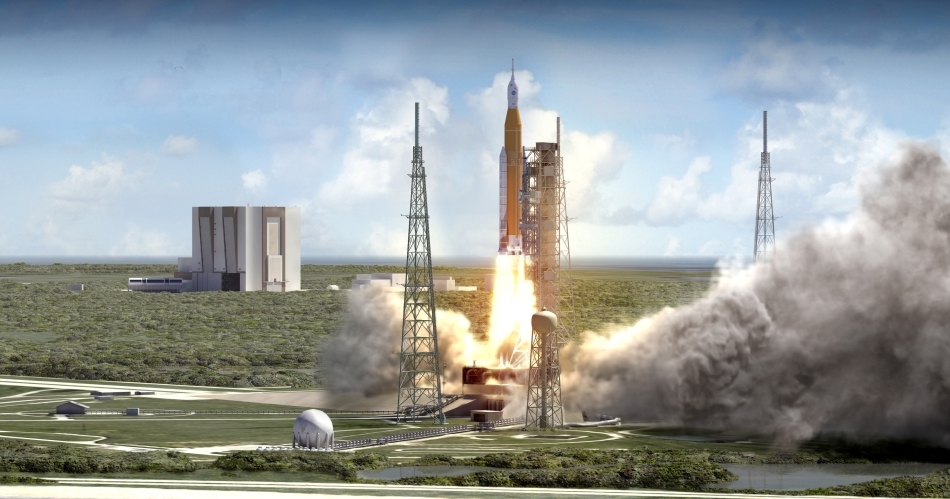
Start SLS Block 1, NASA illustration

Engine tests, freeze-frame from NASA video
On February 22, the first in 2017 test of the RS-25 engine, which used to be on the shuttle, took place, and now it will be the engine of the central unit (second stage) of the SLS. The test turned out to be very beautiful - water droplets from the exhaust of the engine and the stand irrigation system on a sunny day generated not even one, but several rainbows. One of the cameras was standing on the drone for the first time, so we can see unusual angles of the test bench.
')
Moving from lyrics to technical details, this was the twelfth test of the RS-25 engine under the SLS program. At this time, small improvements were checked - a low-pressure fuel pipe and an increased pressure of liquid oxygen at the inlet. The engine has successfully worked 380 seconds. Easy irony is that the RS-25 engine, which was originally developed for multiple use on the Space Shuttle, is now turned into a disposable one - no engine rescue systems or a central unit landing on the SLS is provided. However, this also has its advantages - the draft has already increased from the Shuttle 104.5% from the nominal to 109%, and it seems that they are going to add at least another 2%. In 2017, the engines will have an intensive testing program - flight samples will be tested, which will be put on the first launch, an inspection of the engine management system that will go on the first flight is expected, and then we will be able to see a spectacle unprecedented since the Apollo times - fire tests of the extra heavy rocket stage in the collection. The fully assembled central unit will be installed on a huge stand and will turn on all four engines simultaneously.
This is what Saturn V looked like, the sound is not original.
Interim Cryogenic Propulsion Stage is a lightweight version of the upper (third) stage for the first flight of the SLS. It is called Block 1 and has a carrying capacity of 70 tons in low earth orbit. Technically, ICPS is a modified upper stage of the DCSS of the Delta IV launch vehicle. Since ICPS is based on a serial product, it is almost ready, and the United Launch Alliance development company recently invited the press to look at the stage before sending it to the tests.
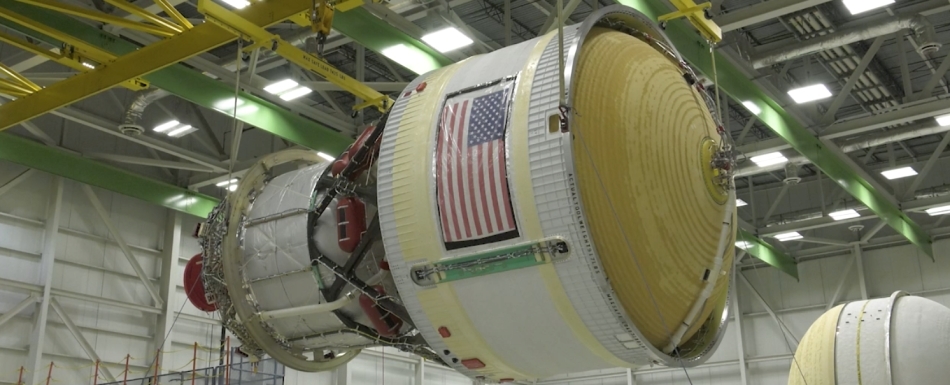
ICPS, NASA photo
On February 22, a test service module for testing the propulsion system (Propulsion Qualification Module, PQM) was installed at the White Sendz site. It is curious that the European development module also uses shuttle operating time - the OMS Space Shuttle orbital maneuvering engine is installed as the main main engine. And the total number of engines on the module is 21 - 1 sustainer, 8 auxiliary and 12 orientation engines. They will all be checked at the White Sands test site.
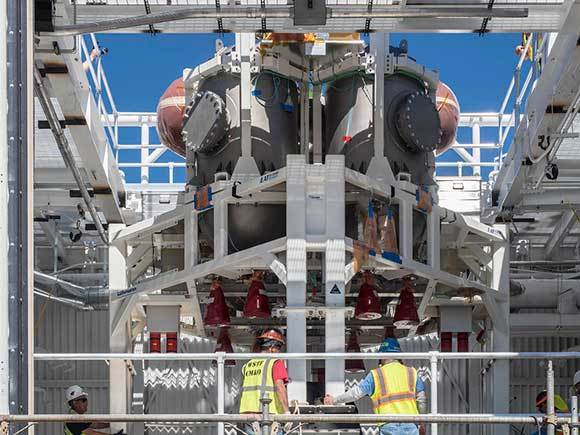
PQM photo by NASA
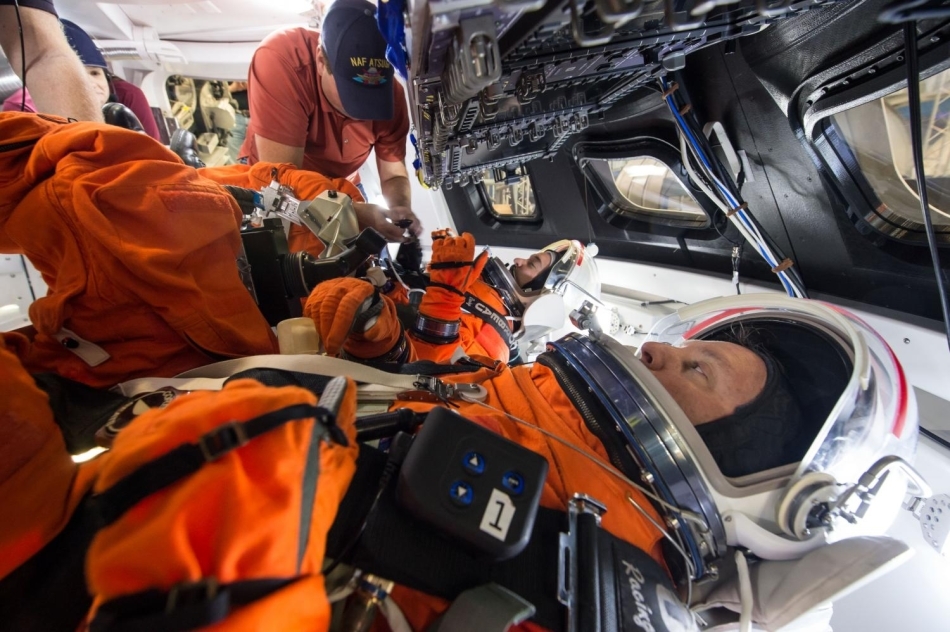
Testing the cabin of the ship Orion, photo NASA
According to the approved plans, at the end of 2018, an unmanned mission of the EM-1, the first flight of the SLS and the Orion ship in full equipment is to be held (the overall layout of the service module was used in the 2014 flight). In it, the ship will have to go round the moon. However, in recent days it turned out that NASA is considering the option of conducting this mission with a crew of two people. According to the initial plans, the first manned mission of the EM-2 was to take place in 2021 and follow the same program, with a flyby of the moon, but with a crew of four people. Thus, the EM-1 and EM-2 missions have become almost identical, and if the EM-1 is manned, the EM-2 plan will have to be changed. In general, the idea of making the first launch manned is very ambiguous. First of all, this is an obvious increase in risk, even if it was consecrated by the successful first flight of the Space Shuttle with the crew immediately. But here to the first flight of the new rocket and the ship all the risks of traveling to the Moon are added. Yes, the ship will be on the trajectory of the so-called "free return", and in order to be on its way to Earth, no maneuvers will be required except for the correction of the trajectory. But the systems of the ship and, in particular, life support will have to work reliably and reliably, because if the moon crashes, then it will not be possible to return to Earth in less than 2-3 days, and people must survive this time. On the other hand, in the case of a manned first mission, money is saved, and in the event of its success, such a flight will remain in history as an example of engineering arrogance that will be hard to beat. Also, on the one hand, changes in the mission plan will lead to the transfer of the start date. But, on the other hand, according to SpaceFlightNow , the planned date for November 2018 already will not be able to withstand, mainly due to delays in the creation of the service module. Also a recent tornado affecting the Michoud Assembly Facility assembly workshop may also affect the shift in plans. Information comes contradictory, someone says the absence of serious damage, others report shifts in terms of months.
The ambiguity of the idea causes the reaction of other organizations. The NASA Independent Security Committee has already asked for "irrefutable rationale" for such a decision. The fact is that the unmanned version of the EM-1 will allow the equipment to be tested at the limit of its capabilities, which for security reasons cannot be done in a manned mission. And the financial gain from “saving” one flight and moving to more complex tasks in EM-2 is to some extent offset by higher costs for EM-1. And the big time gap between the flights will not be reduced - the mission of the EM-2 is based on equipment, the creation time of which cannot be compressed. The commission also published information about the problems detected with solid-fuel boosters. In the layer between the solid fuel and the accelerator case an “anomaly” was found. Under certain temperature conditions, gas emissions occur that form voids in solid fuels. And this is very dangerous - a cavity in solid fuel leads to a pressure jump during combustion, which in the worst case is able to break the accelerator.
In any case, now there is a process of studying the idea, which will end in late March - early April.
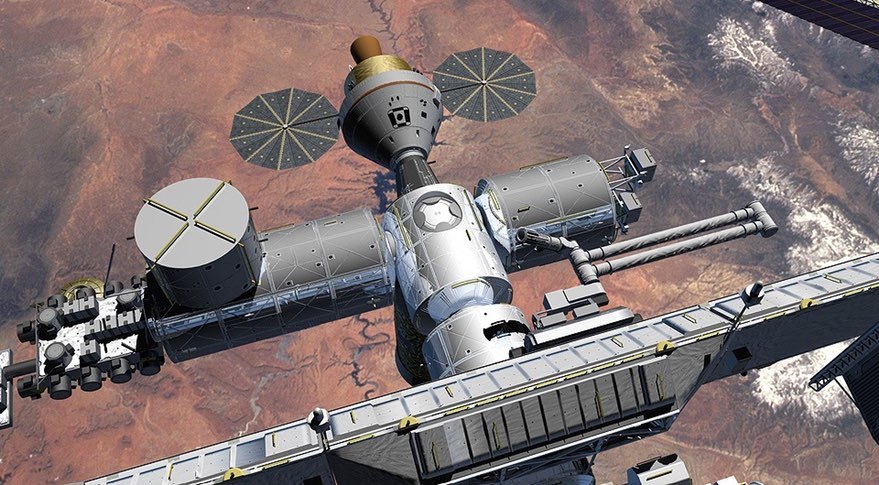
Orion, docked to the ISS, NASA graphics
On February 17, the US Senate in the authorizing bill ordered NASA to study the possibility of using Orion for flights to the ISS. In earlier versions of the project, the ship was developed, including for this, and in the 2010 bill, NASA ordered to give Orion the opportunity to fly to the ISS. But since then, the low near-earth orbit has been deliberately given to private owners, and the question of Orion flights to the ISS has not been raised. The ship itself is not difficult to adapt for the ISS, but there is a problem with the launch vehicle. The first launch of Orion took place on the Delta IV Heavy. This rocket is expensive and not certified to launch people. As a matter of fact, so far no American launch vehicle has received such certification. But, unlike the SLS, which is initially developed in order to be certified and carry people, existing missiles will need to be refined. In principle, Altas V and so were going to modify in order to launch the ship Boeing CST-100 Starliner on it, but it is not known whether Orion can be lightened so that it fits on the Atlas V. In general, the situation painfully resembles the story of Apollo "Who flew to the orbital station Skylab lightweight and unfilled. Ideally, it makes sense to develop a reduced service module specifically for flights to the ISS, but these are additional and rather big expenses that do not make sense if flights to the ISS are not regular. And if they are regular, the question arises what will happen with the existing SpaceX Dragon 2 and Boeing CST-100 Starliner projects, because astronauts are not enough for all the ships - the ISS is not rubber, and more than a dozen permanent crew will not fit.
Curiously, a small cloud begins to appear over SpaceX and Boeing in the same Senate bill - a phrase was added to the bill text that the program for commercial delivery of goods into orbit should be "safe, reliable and at an acceptable level of costs." So far, this does not mean anything, but theoretically the clouds over the “new private owners” can still thicken. Moreover, the other day, the US Accounting Chamber asked NASA to create a backup action plan in case of delays in creating Starliner and Dragon 2. Boeing and SpaceX have already assured that they are working, serious delays are not expected, but NASA’s backup action plan will appear in March. According to rumors, NASA and Roskosmos want to repeat the annual flight of an astronaut and an astronaut, as was the case with Kelly and Kornienko. In this case, one place is released in the middle of 2019. In addition, after the deal with Energia debts on Sea Launch, Boeing has two seats in Soyuz with an option for another three, so in case of delays in developing its ship, backup option remains. In addition, NASA can buy places in the "Unions" for 2019, as it has bought them all of recent years, and this option, judging by the news, is at least working out.
In general, 2017 will be quite interesting for SLS and Orion, we will follow the news.

Start SLS Block 1, NASA illustration
RS-25 engine test

Engine tests, freeze-frame from NASA video
On February 22, the first in 2017 test of the RS-25 engine, which used to be on the shuttle, took place, and now it will be the engine of the central unit (second stage) of the SLS. The test turned out to be very beautiful - water droplets from the exhaust of the engine and the stand irrigation system on a sunny day generated not even one, but several rainbows. One of the cameras was standing on the drone for the first time, so we can see unusual angles of the test bench.
')
Moving from lyrics to technical details, this was the twelfth test of the RS-25 engine under the SLS program. At this time, small improvements were checked - a low-pressure fuel pipe and an increased pressure of liquid oxygen at the inlet. The engine has successfully worked 380 seconds. Easy irony is that the RS-25 engine, which was originally developed for multiple use on the Space Shuttle, is now turned into a disposable one - no engine rescue systems or a central unit landing on the SLS is provided. However, this also has its advantages - the draft has already increased from the Shuttle 104.5% from the nominal to 109%, and it seems that they are going to add at least another 2%. In 2017, the engines will have an intensive testing program - flight samples will be tested, which will be put on the first launch, an inspection of the engine management system that will go on the first flight is expected, and then we will be able to see a spectacle unprecedented since the Apollo times - fire tests of the extra heavy rocket stage in the collection. The fully assembled central unit will be installed on a huge stand and will turn on all four engines simultaneously.
This is what Saturn V looked like, the sound is not original.
Showed ICPS
Interim Cryogenic Propulsion Stage is a lightweight version of the upper (third) stage for the first flight of the SLS. It is called Block 1 and has a carrying capacity of 70 tons in low earth orbit. Technically, ICPS is a modified upper stage of the DCSS of the Delta IV launch vehicle. Since ICPS is based on a serial product, it is almost ready, and the United Launch Alliance development company recently invited the press to look at the stage before sending it to the tests.

ICPS, NASA photo
Brought a test service module
On February 22, a test service module for testing the propulsion system (Propulsion Qualification Module, PQM) was installed at the White Sendz site. It is curious that the European development module also uses shuttle operating time - the OMS Space Shuttle orbital maneuvering engine is installed as the main main engine. And the total number of engines on the module is 21 - 1 sustainer, 8 auxiliary and 12 orientation engines. They will all be checked at the White Sands test site.

PQM photo by NASA
Manned dilemma

Testing the cabin of the ship Orion, photo NASA
According to the approved plans, at the end of 2018, an unmanned mission of the EM-1, the first flight of the SLS and the Orion ship in full equipment is to be held (the overall layout of the service module was used in the 2014 flight). In it, the ship will have to go round the moon. However, in recent days it turned out that NASA is considering the option of conducting this mission with a crew of two people. According to the initial plans, the first manned mission of the EM-2 was to take place in 2021 and follow the same program, with a flyby of the moon, but with a crew of four people. Thus, the EM-1 and EM-2 missions have become almost identical, and if the EM-1 is manned, the EM-2 plan will have to be changed. In general, the idea of making the first launch manned is very ambiguous. First of all, this is an obvious increase in risk, even if it was consecrated by the successful first flight of the Space Shuttle with the crew immediately. But here to the first flight of the new rocket and the ship all the risks of traveling to the Moon are added. Yes, the ship will be on the trajectory of the so-called "free return", and in order to be on its way to Earth, no maneuvers will be required except for the correction of the trajectory. But the systems of the ship and, in particular, life support will have to work reliably and reliably, because if the moon crashes, then it will not be possible to return to Earth in less than 2-3 days, and people must survive this time. On the other hand, in the case of a manned first mission, money is saved, and in the event of its success, such a flight will remain in history as an example of engineering arrogance that will be hard to beat. Also, on the one hand, changes in the mission plan will lead to the transfer of the start date. But, on the other hand, according to SpaceFlightNow , the planned date for November 2018 already will not be able to withstand, mainly due to delays in the creation of the service module. Also a recent tornado affecting the Michoud Assembly Facility assembly workshop may also affect the shift in plans. Information comes contradictory, someone says the absence of serious damage, others report shifts in terms of months.
The ambiguity of the idea causes the reaction of other organizations. The NASA Independent Security Committee has already asked for "irrefutable rationale" for such a decision. The fact is that the unmanned version of the EM-1 will allow the equipment to be tested at the limit of its capabilities, which for security reasons cannot be done in a manned mission. And the financial gain from “saving” one flight and moving to more complex tasks in EM-2 is to some extent offset by higher costs for EM-1. And the big time gap between the flights will not be reduced - the mission of the EM-2 is based on equipment, the creation time of which cannot be compressed. The commission also published information about the problems detected with solid-fuel boosters. In the layer between the solid fuel and the accelerator case an “anomaly” was found. Under certain temperature conditions, gas emissions occur that form voids in solid fuels. And this is very dangerous - a cavity in solid fuel leads to a pressure jump during combustion, which in the worst case is able to break the accelerator.
In any case, now there is a process of studying the idea, which will end in late March - early April.
Branch to ISS

Orion, docked to the ISS, NASA graphics
On February 17, the US Senate in the authorizing bill ordered NASA to study the possibility of using Orion for flights to the ISS. In earlier versions of the project, the ship was developed, including for this, and in the 2010 bill, NASA ordered to give Orion the opportunity to fly to the ISS. But since then, the low near-earth orbit has been deliberately given to private owners, and the question of Orion flights to the ISS has not been raised. The ship itself is not difficult to adapt for the ISS, but there is a problem with the launch vehicle. The first launch of Orion took place on the Delta IV Heavy. This rocket is expensive and not certified to launch people. As a matter of fact, so far no American launch vehicle has received such certification. But, unlike the SLS, which is initially developed in order to be certified and carry people, existing missiles will need to be refined. In principle, Altas V and so were going to modify in order to launch the ship Boeing CST-100 Starliner on it, but it is not known whether Orion can be lightened so that it fits on the Atlas V. In general, the situation painfully resembles the story of Apollo "Who flew to the orbital station Skylab lightweight and unfilled. Ideally, it makes sense to develop a reduced service module specifically for flights to the ISS, but these are additional and rather big expenses that do not make sense if flights to the ISS are not regular. And if they are regular, the question arises what will happen with the existing SpaceX Dragon 2 and Boeing CST-100 Starliner projects, because astronauts are not enough for all the ships - the ISS is not rubber, and more than a dozen permanent crew will not fit.
Curiously, a small cloud begins to appear over SpaceX and Boeing in the same Senate bill - a phrase was added to the bill text that the program for commercial delivery of goods into orbit should be "safe, reliable and at an acceptable level of costs." So far, this does not mean anything, but theoretically the clouds over the “new private owners” can still thicken. Moreover, the other day, the US Accounting Chamber asked NASA to create a backup action plan in case of delays in creating Starliner and Dragon 2. Boeing and SpaceX have already assured that they are working, serious delays are not expected, but NASA’s backup action plan will appear in March. According to rumors, NASA and Roskosmos want to repeat the annual flight of an astronaut and an astronaut, as was the case with Kelly and Kornienko. In this case, one place is released in the middle of 2019. In addition, after the deal with Energia debts on Sea Launch, Boeing has two seats in Soyuz with an option for another three, so in case of delays in developing its ship, backup option remains. In addition, NASA can buy places in the "Unions" for 2019, as it has bought them all of recent years, and this option, judging by the news, is at least working out.
In general, 2017 will be quite interesting for SLS and Orion, we will follow the news.
Source: https://habr.com/ru/post/401897/
All Articles